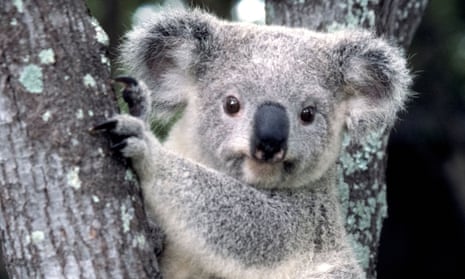Australia’s environmental offset system is “ridiculous” and must change to prevent the koala being wiped out in several areas of the country, according to the Australian Koala Foundation.
The koala has seen much of its habitat cleared for urban expansion and industry, with the marsupial also considered particularly vulnerable to climate change. It was listed as vulnerable in Queensland, New South Wales and the Australian Capital Territory in 2012.
In a submission to a Senate inquiry into environmental offsets, the foundation called for a change to the system whereby the government can approve a development if the proponent promises to “offset” the destruction of native habitat by safeguarding equivalent habitat elsewhere.
Critics claim the system allows for the destruction of irreplaceable vegetation, dooming the animals that rely upon it.
Deborah Tabart, the chief executive of the foundation, said there was “so much wrong” with the idea of offsets.
“Think about it from the point of view of a koala,” she said. “Your tree has been chopped down. What are offsets going to do for you?
“You have a pretty good chance of getting hit by a car or mauled by a dog as you are pushed out of your home. If you can manage to survive the initial eviction, you still have to figure out where you are supposed to go to find this new offset area, this promised land.
“And then, once you have managed to get to this reservation, it’s still going to be years before the new trees are of any use to you, and even longer before the ecosystem is completely restored, if ever. I mean, who thought this up anyway? It is ridiculous.”
Tabart said she was concerned by the government’s recent record, such as the approval of a large coal mine, owned by Clive Palmer, which will raze the Bimblebox nature reserve in Queensland.
“The development proponents are exaggerating the value of what they are proposing, and government isn’t putting the right price on the risks of what they are being sold,” she said.
A University of Queensland study has found that “smart” planning of roads and forested areas is needed to maintain the genetic diversity of koalas and ultimately ensure the species’ survival.
The research mapped out how tree cover and roads affected the gene flow of koalas across south-east Queensland.
Researchers found healthy dispersal of koala genes “dropped rapidly” once the percentage of forest cover fell below 30%. Areas with little or no forest cover had rates of gene flow three times lower than areas where forest cover was 100%.
While koalas spend most of their time in trees, they do move between areas to mate, thereby spreading genetic diversity – a crucial process for the survival of the species.
“Koala numbers have dropped massively over the past 15 years in south-east Queensland, and further urbanisation will affect them more,” said Jonathan Rhodes, the co-author of the report.
“We also found that the presence of highways reduces gene flow dramatically compared to areas without roads.
“To keep, create or maintain connections between koala populations, at least 30% forest cover should be planned for.
“It’s vital that koalas are able to move across the landscape and that we do all we can in urban planning to ensure we do not isolate their habitats.”

Comments (…)
Sign in or create your Guardian account to join the discussion